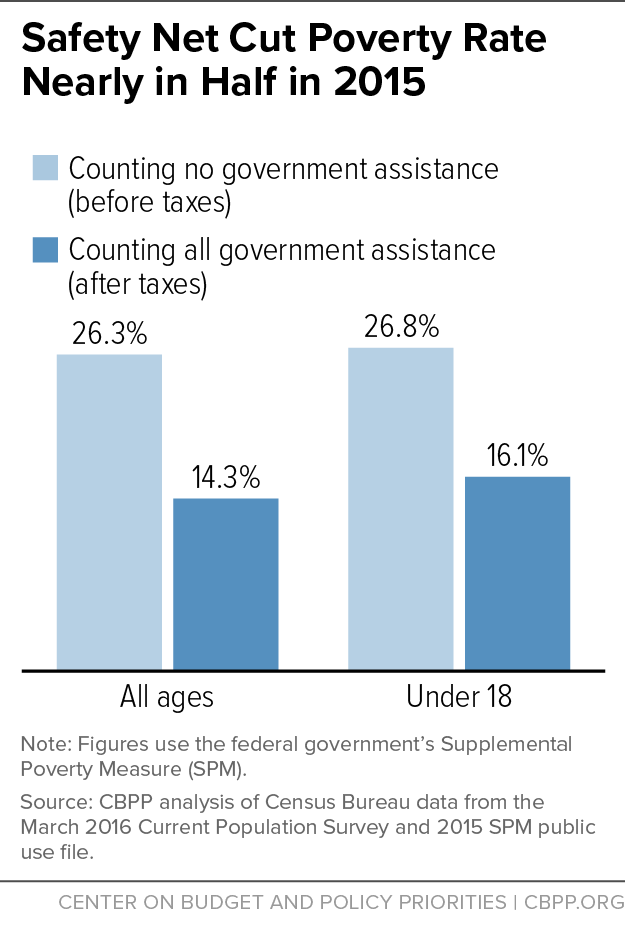BEYOND THE NUMBERS
Safety net programs cut the poverty rate nearly in half in 2015, lifting 38 million people — including 8 million children — above the poverty line, our analysis of Census data released yesterday finds. The Census data show the impact of a broad range of government assistance, such as Social Security, SNAP (formerly food stamps), Supplemental Security Income, rent subsidies, and tax credits for working families like the Earned Income Tax Credit (EITC) and Child Tax Credit. The figures rebut claims that government programs do little to reduce poverty.
Government benefits and taxes cut the poverty rate from 26.3 percent to 14.3 percent in 2015. Among children, they cut the poverty rate from 26.8 percent to 16.1 percent (see chart). This analysis uses the Census Bureau’s Supplemental Poverty Measure (SPM), which counts various government non-cash benefits as income, as most analysts favor.
Safety net programs cut poverty significantly across all age and racial/ethnic groups the Census data cover. For example, they lifted 23.3 million white non-Hispanics, 6.1 million black non-Hispanics, 6.7 million Hispanics, and 800,000 Asians above the poverty line in 2015. (See table.)
| Number of People Lifted Above Poverty Line in 2015, by Age, Race, and Ethnicity | |||||
|---|---|---|---|---|---|
| White | Black | Hispanic | Asian | All races & ethnicities | |
| Children under 18 | 2,500,000 | 1,900,000 | 2,800,000 | 200,000 | 7,900,000 |
| 18-64 year olds | 6,600,000 | 2,700,000 | 2,700,000 | 200,000 | 12,600,000 |
| 65 years and older | 14,100,000 | 1,500,000 | 1,300,000 | 400,000 | 17,600,000 |
| All ages | 23,300,000 | 6,100,000 | 6,700,000 | 800,000 | 38,100,000 |
Figures may not add to totals due to rounding. Source: CBPP analysis of Census Bureau data from the March 2016 Current Population Survey and 2015 SPM public use file
These figures understate the safety net’s effectiveness because they don’t correct for households’ underreporting of government benefits. Household surveys depend on participants’ recollections over many months and typically fail to capture some income; the Census data are no exception. In 2012, the most recent year for which we have data corrected for such underreporting, the safety net lowered the SPM poverty rate from 29.1 percent to 13.8 percent — a poverty rate 2.2 percentage points lower than in SPM data without these corrections.
Policymakers negotiating budget and tax priorities should keep in mind that the safety net keeps millions of children, adults, and seniors of all races and ethnicities from falling below the poverty line. Deep cuts to these programs would make them much less effective at reducing poverty and would push the U.S. poverty rate substantially higher.

